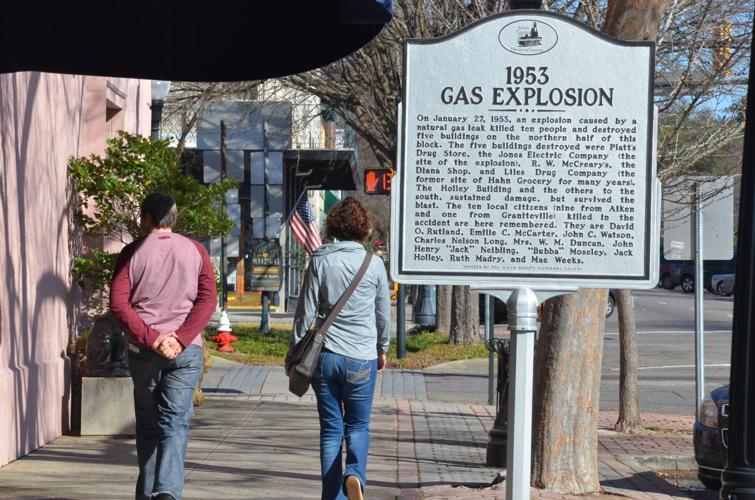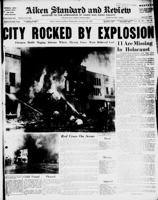Horace Bouknight saw everything.
The former Aiken resident was standing on Laurens Street around 8:30 a.m., Jan. 27, 1953. It was a Tuesday.
Bouknight was 20 years old the time when a massive explosion in front of the Jones Electric Company building sent glass flying across four city blocks, according to news reports from the time.
"I saw it all," said Bouknight, now 83 and living in Milledgeville, Georgia. I was right there. I knew the people that died in the explosion."
It was 64 years ago today when an explosion caused by a gas leak in the basement of a downtown Aiken business claimed 10 lives and injured five others, and left behind scars in the downtown cityscape still visible to this day.
At 8:31 a.m., a natural gas explosion ripped through the basement of the Jones Electric Company, and forever changed the lives of those who called this idyllic Southern town home.
The scene was described by the Aiken Standard and Review on Wednesday, Jan. 28, as being "a holocaust."
A total of 10 people were killed in the blast. Five more were injured in the inferno of flames to follow as firefighters from Aiken, the Savannah River Site, New Ellenton and Graniteville battled the fire long into the night.
There were 10 fatalities in all, according to accounts and news stories, though the initial reports feared 11 may have perished.
Hundreds lingered on Laurens Street throughout the night to watch as firefighters battled the blaze and rescue workers sifted through the rubble in search of bodies.
The dead, who were memorialized on a marker erected on Laurens Street at the spot of the explosion in 2009, are: Leila Mae Weeks, David O. Rutland, Emilie C. McCarter, John C. Watson, Charles Nelson Long, Mrs. R.B. Dunkin, John Henry (Jack) Neibling, James "Bubba" Moseley, Jack Holley and Ruth Madrey.
The buildings destroyed in the blast included Jones Electric Company, located between Hayne and Richland avenues on Laurens Street, where the explosion occurred. Also, the intense fire overtook four more buildings: McCreary Dry Goods, Liles Drugs, the Diana Shop and Platt Drugstore.
The explosion destroyed a city block on Laurens Street between Hayne and Richland Avenues, with damage estimated at $2 million. Today, that would equate to slightly more than $18 million accounting for inflation.
Those who heard, saw and felt it
Had it not been for a flat tire that morning on Bouknight's way to work at the Firestone store in town, he'd have been standing out front with the woman who had been trapped beneath the rubble when the building collapsed.
"I used to run and get coffee for all the people every morning – it was my little side hustle to earn extra money," Bouknight said. "I had just got there. We had a flat tire and we were late. Had it not been for the flat tire I’d have been standing right there in front with the lady that was trapped in the explosion."
An electric spark in the gas-filled basement of the Jones Electric Company building on Laurens Street was determined to be the culprit of the blast that leveled one building and burned four others downtown.
The explosion's concussion could be felt for miles and shattered windows encompassing a four-block area downtown.
Bubba Moseley, a Jones Electric Company employee and a friend of Bouknight's, was an aspiring boxer, who delivered gas tanks to Jones Electric Company customers.
"They used to keep the natural gas tanks in the basement," he said. "Nobody knew about sparks and fire back then, but Bubba went home and left a gas tank open. The next morning he was down in the basement looking for a light switch and he struck a match."
Other accounts claim a spark from a fan caused the blast. What ties the accounts is the natural gas leak in the basement.
The first victim pulled from the rubble of the explosion was 64-year-old Leila Mae Weeks, who was identified by her shoe because her leg was missing, according to a Jan. 28, 1953, in the Aiken Standard and Review.
"There was a woman standing out front who got buried in the explosion," Bouknight said. "She was trapped beneath a beam and was crying out for help. I told the doctor he needed to give the woman the needle so she would go to sleep and stop screaming. It was about that time, the bricks started swaying and the whole building came down on top of her."
That day changed him, Bouknight said.
"I never came back. Never had the time, but I always thought about that day and the people that died. It's always bothered but I’ve been blessed," he said. "I’ve seen a lot. I’ve seen a lot."
Local historians look back
Area historian Owen Clary was in school on the day of the explosion, sitting in study hall at Graniteville High School.
"We were in class that morning when someone came in and said, 'They dropped a bomb on Aiken,'" he said.
Given that it was the height of the 1950s Cold War, Clary said the news appeared sketchy.
"We didn't know," he said, adding there was just radio at the time. "It was a terrifying time here. People didn't know exactly what had happened. The Savannah River Site had just opened, and we called that 'The Bomb Plant.'"
Clary said he and his friends shared a car, so during lunch he and some classmates drove to town.
"We got as far as the old county hospital and we had to stop," he said. "We walked the rest of the way into town. We couldn't get close to the explosion as police had set up barricades around Laurens Street, but we could see the smoke and the debris from the explosion."
Clary and his classmates returned to school, though late, and were admonished by the principal for their tardiness.
"We received a good chewing out for being late," he said. "Nobody really knew what had happened until the next day."
Clary has kept a diary every day since Jan. 1, 1949. His entry for Jan. 27, 1953, said simply, "Horrible day."
Archived accounts
Newspaper reports differ on some accounts of the explosion. Homer Long was quoted in the Jan. 28, 1953, Standard and Review article saying he and his brother Nelson were down in the basement getting supplies when the explosion occurred.
"The basement was so full of gas I could hardly see," Long said. "I went to close a warehouse door that had been left open and the whole building blew up and caved in on Nelson in the basement."
Earl Norris, a contractor, rushed to the McCreary store immediately after the blast to help with the rescue work. The flames were just starting to spring up.
Here, the account Norris gave matched Bouknight's recollections.
"We pulled two people out and then came to this lady trapped under a beam," he said. "We got her part way out and then the fire shot up around us and we had to leave her in the flames. She was conscious and just staring at us when we left."
Russell Owens, a Jones Electric employee who had just left the building to get breakfast, said the heat was too intense for anyone to do much.
"It was horrible," Owens said in a Jan. 28, 1953, in another media report. "We wanted to do more – but the fire was was too great and the heat was too intense. We tried to get into our place but we couldn't. Our friends were in there – but we couldn't do anything about it."
According to accounts, a pair of local men helped pull victims from the flames and rubble.
As crews fought the fire, the cries of victims caught in the rubble could be heard. Earl Young and Ray Hydrick pulled four people who were trapped in the debris to safety.
Young was laying bricks at a job site near what is today Pruitt Health-Aiken on Laurens Street, just north of downtown Aiken.
Young, who was working with his brother, Norris, that morning heard the noise and felt the ground shake, although they were at least a mile from the explosion. Young thought it might have been the old boiler in the basement of Aiken Elementary School on Chesterfield Street, now home of the Aiken County Public Library.
Young helped pull four people to safety from the rubble left by the explosion, according to a story in the Aiken Standard on Sept. 27, 2009.
He received a plaque that year from the Aiken Department of Public Safety at the unveiling of an historical marker to remember the explosion and honor the 10 Aiken and Graniteville residents who died.
The inscription on the plaque reads: "On this spot on Jan. 27, 1953, an explosion caused by a natural gas leak destroyed the Jones Electric Co. building and damaged Holley Hardware, Platt's Drug Store, R.W. McCreary's, The Diana Shop and Liles Drug Company. The explosion and ensuing fire left a gaping hole in the face of downtown Aiken. Ten citizens of Aiken were killed in the accident and are here remembered. They are Leila Mae Weeks, David O. Rutland, Emilie C. McCarter, John C. Watson, Charles Nelson Long, Mrs. R.B. Dunkin, John Henry (Jack) Neibling, James "Bubba" Moseley, Jack Holley and Ruth Madrey."
Young died in July 2016.
Hydrick was honored as Aiken Rotary’s Man of the Year in 1981. He died in August 2016, a month after Young.
Victims shocked, disoriented
Two other people inside, who Young described as “shell-shocked and disoriented,” were taken out of the building, but the screaming woman remained. Covered in debris, she was pinned under a large beam across her body.
“At the same time we went into the building, the roof was on fire,” Young said. “We didn’t have much time, but when you see something like that, you just try and help. You don’t think about yourself.”
Young, his brother and others rescued the woman from the building and carried her to the sidewalk just before the remaining ceiling collapsed to the floor.
Although they didn’t talk to local reporters who covered the explosion, their names appeared in the newspaper the next day.
"Just a man trying to help"
Young said people in Aiken knew most everyone then, and that someone who knew them and had been interviewed must have told the paper about he and his brother’s heroism.
Young, however, denied being a hero himself.
“I’m no hero. I was just a man trying to help.”
It took several hours to extinguish the flames and several years to repair the damage done to the block of Laurens Street between Richland Avenue and Hayne Street.
















